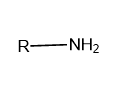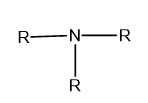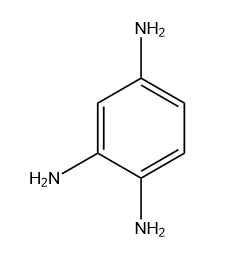
Triaminobenzene is a
(a) \[{2^ \circ }\]amine
(b) \[{3^ \circ }\]amine
(c) \[{1^ \circ }\]amine
(d) Quaternary salt
Answer
223.5k+ views
Hint: Amines are belonging to the class of organic molecules, which contains nitrogen atoms. Amines are formed by the replacement of one or more hydrogen atoms of ammonia molecules (\[N{H_3}\]) by the alkyl and aryl groups.
Complete step-by-step answer:
Amines are present in various biomolecules such as proteins, vitamins, hormones, etc. They are also used in industries for making detergents and various kinds of drugs.
Amines are derivatives of ammonia. Depending upon the number of alkyl or aryl groups, the amines can be classified as primary (\[{1^ \circ }\]), secondary (\[{2^ \circ }\]), and tertiary (\[{3^ \circ }\]).
Primary (\[{1^ \circ }\]): If only one alkyl or aryl group is attached to the nitrogen atom of ammonia then it is called Primary or \[{1^ \circ }\] amine.

Image: General structure of primary amine, where R represents the aryl and alkyl group.
Secondary (\[{2^ \circ }\]): If two alkyl or aryl groups are attached to the nitrogen atom of ammonia then it is called secondary or \[{2^ \circ }\]amine.

Image: General structure of secondary amine, where R represents the aryl and alkyl group.
Tertiary (\[{3^ \circ }\]): If three alkyl or aryl group is attached to the nitrogen atom of ammonia then it is called tertiary or \[{3^ \circ }\] amine .

Image: General structure of tertiary amine, where R represents the aryl and alkyl group.
The naming of amines:
According to IUPAC the naming of aliphatic amines can be done by writing the name alkyl before the name of amine and therefore the name of amine will be alkylamine i.e., alkyl part + amine =methylamine.
For example, The IUPAC name of \[C{H_3}N{H_2}\] can be done by adding the name of the alkyl group i.e., \[ - C{H_3}\] group before the name of amine. Hence the name of \[C{H_3}N{H_2}\]will be methylamine.
In the case of secondary (\[{2^ \circ }\]) and tertiary (\[{3^ \circ }\]) amine, the prefixes di and tri are used before the name of the alkyl group.
Hence, from the above discussion. Option (c) will be the correct answer because in triaminobenzene only one hydrogen atom is replaced by the aromatic ring.

Image: Structure of triaminobenzene.
Note: In some cases, the amines contain more than one amino group. Then the location of the amino group is defined by the numbering of the carbon atoms in the parent chain. The numbering will start from where the carbon atom bearing \[ - N{H_2}\] group get the lowest numbers. Therefore, prefixes along with the number of amino groups and their position in the molecule.
For example, \[N{H_2} - C{H_2} - C{H_2} - N{H_2}\] can be named as ethane 1, 2-diamine.
Complete step-by-step answer:
Amines are present in various biomolecules such as proteins, vitamins, hormones, etc. They are also used in industries for making detergents and various kinds of drugs.
Amines are derivatives of ammonia. Depending upon the number of alkyl or aryl groups, the amines can be classified as primary (\[{1^ \circ }\]), secondary (\[{2^ \circ }\]), and tertiary (\[{3^ \circ }\]).
Primary (\[{1^ \circ }\]): If only one alkyl or aryl group is attached to the nitrogen atom of ammonia then it is called Primary or \[{1^ \circ }\] amine.

Image: General structure of primary amine, where R represents the aryl and alkyl group.
Secondary (\[{2^ \circ }\]): If two alkyl or aryl groups are attached to the nitrogen atom of ammonia then it is called secondary or \[{2^ \circ }\]amine.

Image: General structure of secondary amine, where R represents the aryl and alkyl group.
Tertiary (\[{3^ \circ }\]): If three alkyl or aryl group is attached to the nitrogen atom of ammonia then it is called tertiary or \[{3^ \circ }\] amine .

Image: General structure of tertiary amine, where R represents the aryl and alkyl group.
The naming of amines:
According to IUPAC the naming of aliphatic amines can be done by writing the name alkyl before the name of amine and therefore the name of amine will be alkylamine i.e., alkyl part + amine =methylamine.
For example, The IUPAC name of \[C{H_3}N{H_2}\] can be done by adding the name of the alkyl group i.e., \[ - C{H_3}\] group before the name of amine. Hence the name of \[C{H_3}N{H_2}\]will be methylamine.
In the case of secondary (\[{2^ \circ }\]) and tertiary (\[{3^ \circ }\]) amine, the prefixes di and tri are used before the name of the alkyl group.
Hence, from the above discussion. Option (c) will be the correct answer because in triaminobenzene only one hydrogen atom is replaced by the aromatic ring.

Image: Structure of triaminobenzene.
Note: In some cases, the amines contain more than one amino group. Then the location of the amino group is defined by the numbering of the carbon atoms in the parent chain. The numbering will start from where the carbon atom bearing \[ - N{H_2}\] group get the lowest numbers. Therefore, prefixes along with the number of amino groups and their position in the molecule.
For example, \[N{H_2} - C{H_2} - C{H_2} - N{H_2}\] can be named as ethane 1, 2-diamine.
Recently Updated Pages
JEE Main 2026: Exam Dates OUT, Registration Open, Syllabus & Eligibility

JEE General Topics in Chemistry Important Concepts and Tips

JEE Extractive Metallurgy Important Concepts and Tips for Exam Preparation

JEE Atomic Structure and Chemical Bonding important Concepts and Tips

JEE Amino Acids and Peptides Important Concepts and Tips for Exam Preparation

Electricity and Magnetism Explained: Key Concepts & Applications

Trending doubts
Understanding Atomic Structure for Beginners

Half Life of Zero Order Reaction for JEE

Understanding Average and RMS Value in Electrical Circuits

Understanding Collisions: Types and Examples for Students

Understanding Inertial and Non-Inertial Frames of Reference

Understanding Displacement and Velocity Time Graphs

Other Pages
JEE Advanced Weightage 2025 Chapter-Wise for Physics, Maths and Chemistry

Understanding How a Current Loop Acts as a Magnetic Dipole

NCERT Solutions For Class 12 Chemistry Chapter 2 Chapter 2 Solutions Hindi Medium in Hindi - 2025-26

JEE Advanced 2026 Revision Notes for Practical Organic Chemistry

CBSE Class 12 Chemistry Question Paper Set 3 2025 with Answers

An alcohol A gives Lucas test within 5 minutes 74 g class 12 chemistry JEE_Main




